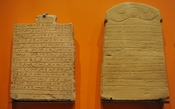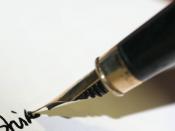Ryan Diedrich Professor Griegel 30 March 2000 The Unheard Writing One day, in the second grade, the teacher told our class to get out their lined paper and pencils. As I made that first fancy loop, following the example on the board, I was wondering what possible situation I was getting into. Later in the year, I learned that cursive writing was time consuming and very difficult to master. In high school, I found out that we had a choice of cursive or printing. I asked myself why we needed cursive? Why are others putting aside this writing that consumed so much time? What are the pros and cons of cursive? This type of writing is established, and I never thought to evaluate its effectiveness or its need until now.
One such pro is that cursive an established form of writing. In grade school, we learned how to neatly write the cursive alphabet.
The reason that so much time was spent on this area of development is because it is seen as professional writing. The teacher wanted to prepare us for the future, and without this ability we would be unable to read or write this type of writing. For example, many professional forms such as taxes, weekly paycheck and legal papers all require a signature.
Adding on to that, your signature is unique to each and ever one of us. In all the people in the world, there is only one signature that is like yours and that is your own. Yes, it is possible to forge a persons signature, but it is highly unlikely to be a precise copy of the original. For instance, most colleges require students to sign their exams. This procedure prevents the acts of cheating. Moreover, banks have convicted many people of forge checks.


